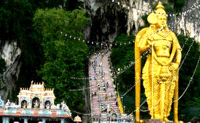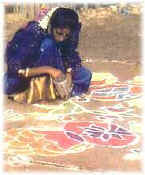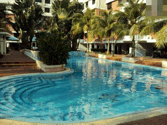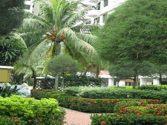| |
Thaipusam Festival - 7th February 2012
Hindu devotees honour Lord Muruga with a sombre parade that
ends at Sri Subramaniam Deasthanan Temple in Batu Berendam.
Here followers ceremoniously tout wooden arches and undergo
ritualistic piercing to cleanse themselves of sin. These
rituals can become quite intense, and those who participate
go into a trance that helps them cope with the experience. Subramaniam Deasthanan Temple in Batu Berendam.
Here followers ceremoniously tout wooden arches and undergo
ritualistic piercing to cleanse themselves of sin. These
rituals can become quite intense, and those who participate
go into a trance that helps them cope with the experience.
The Wangkang Festival - 1st to
6th February 2012
The Wangkang Festival is of Hokkien origin, and it is help
in China, only in Chiang Chew Hoo and Chuan Chew Hoo ( 2
very large districts of the Hokkien province ) and in
Malacca. In the early days, it was also help in Manila, but
I don’t know whether it is still being held there or not. I
have heard of it also being held in Sarawak.

During the persecution of the Chinese by the Manchus in the
Ching Dynasty about 3 centuries ago, a great many Hokkien
people emigrated from China and some of them sailed towards
Malaya, and the first country they reached was Malacca,
where they settled down and worshipped the Ong Yahs as they
had been used to in their own country. As customary, their
descendants – the straits-Born Chinese – followed their
footsteps in worshipping five Ong Yahs and this is why
Malacca is the only place in Malaya, where the Wangkang
procession is held.
The five Ong Yahs according to seniority are : -
1. Choo Hoo Ong Yah - Temple at Kandang.
2. Hoon Hoo Ong Yah - Temple at Kampong Tiga, Kubu.
3. Tee Hoo Ong Yah - Temple at Bandar Hilir.
4. Lee Hoo Ong Yah - Not Temple, but a shrine accommodated
in Malacca Hainan Association at Jonker Street.
5. Pek Hoo Ong Yah - No Temple, but a shrine accommodated at
Yong Chuan Tian.
The legendary account of the Ong Yahs is quite interesting.
During the reign of Eng Lock Koon in the Ming Dynasty about
5 centuries ago, there lived a man who was famous for his
supernatural power. He was the high priest of Taoism named
Teo Tian Soo. The Emperor wishing to test his ability got
together 360 Chin Soos or scholars to play music in the
underground cell of his royal palace. At the height of the
music, the Emperor sent for the high priest and asked him to
stop it. The high priest declared the musicians were not
devils, and he could silence them if only the emperor would
take responsibility of their lives. Based on the Emperor
assent, he sprinkled a handful of a mixture of rice and salt
ion the floor and struck it with his magic sword with the
result that the heads of the 360 scholars were completely
severed. On the very night, the indignant and dissatisfied
souls appeared before the Emperor and demanded their lives
of him. The high priest was summoned and asked to make the
scholars come to life again which feat was an impossible for
him.
Melaka Thai Pongal Festival Date - 14 January
2012
The four days of Pongal have there own individual
significance. Held in the middle of January, Pongal
continues through the first four days of Thai month that
starts in the mid-January. The word Pongal literally means
"boiling over" and is celebrated by Hindus to mark the
harvesting of the bounteous crops in the fields.
Pongal, known as Sweet rice,
is cooked in a new earthenware pot.

The houses are cleaned, painted
and decorated and Kolam's (ground patterns made out of rice
flour) are made in the front yards of the houses. The day
begins with the making of Kolams at the entrance of homes,
as early as possible, in the morning. It is auspicious to
draw the Kolams before sunrise so that the sun god can see
them and come to bless the particular household.
Kolam patterns being drawn with rice flour Every household,
prides itself on making the most exquisite floor drawings
outside their homes. These patterns drawn with rice flour,
dyed in brilliant hues It is an art handed down from one
generation to the other. Kolams (ground patterns made out of
rice flour) generally drawn with rice flour are special to
the occasion. The idea behind using rice flour is that the
insects would feed on it and bless the household.

Sweet rice, known as Pongal, is cooked in a new earthenware
pot at the same place where puja is to be performed. Fresh
turmeric and ginger are tied around this pot. Then a
delicious concoction of rice, moong dal, jaggery and milk is
boiled in the pot on an open fire.
This Pongal, according to ritual, is allowed to boil over
and spill out of the pot. Once the Pongal is ready it is
tempered with cashew nuts and raisins fried in ghee. Pongal,
once ready, is offered to God first, on a new banana leaf
along with other traditional delicacies like vadas, payasam,
etc. Besides this, sugarcane, grain, sweet potatoes etc. are
also offered to the Sun God.
The following day is known as Mattu Pongal or the Pongal of
the cow - a day dedicated to the revered cow. The fourth day
of Pongal also holds special importance. This is the day
when the bond between friends and relatives are
re-strengthened by visiting their homes and sharing thoughts
of love and care.
|











|


 Subramaniam Deasthanan Temple in Batu Berendam.
Here followers ceremoniously tout wooden arches and undergo
ritualistic piercing to cleanse themselves of sin. These
rituals can become quite intense, and those who participate
go into a trance that helps them cope with the experience.
Subramaniam Deasthanan Temple in Batu Berendam.
Here followers ceremoniously tout wooden arches and undergo
ritualistic piercing to cleanse themselves of sin. These
rituals can become quite intense, and those who participate
go into a trance that helps them cope with the experience.








